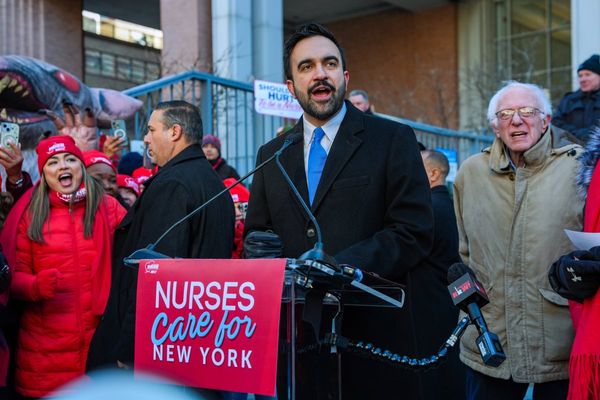
Small businesses are referred to as the backbone of the economy for a reason. They employ 46% of American workers and make up nearly half of GDP, and they boomed during the pandemic as new business applications set records. But things have turned the other direction in the last year, first because of soaring inflation and then major regional bank failures—headlined by the second and third-largest collapses ever, at Silicon Valley Bank and Signature Bank. The specter of banking consolidation is rising, and with it an even more challenging economic environment for small business, raising the questions: What becomes of the entrepreneur if their local bank goes away? Is the banking system stable? And is a credit crunch on the horizon? Underscoring the open nature of this debate, expert opinion is split.
Treasury Secretary Janet Yellen has said that the banking situation is “stabilizing,” and Citigroup CEO Jane Fraser said the recent chaos “is not a credit crisis,” rather just a few banks with isolated problems. But “Dr. Doom” himself, the economist Nouriel Roubini, warned this week that the banking crisis could spark an economic “trilemma” leading to a recession and, eventually, significant credit risk. And finally, Federal Reserve Chair Jerome Powell cautioned last week that the banking collapses are “likely to result in tighter credit conditions for households and businesses, which would in turn affect economic outcomes.”

A credit crunch would be a blow to any company, but is especially deadly for a small business with fewer resources. “Big companies have a lot of internal reserves that they can turn to. They've got other sources of finance,” David Audretsch, editor-in-chief of the Small Business Economics academic journal, told Fortune, while small businesses tend to “take the hit” when interest rates rise and liquidity dries up.
The problem is magnified when considering the ongoing troubles at many small banks which have typically been the lifeblood of small business. Years of banking consolidation have caused lending to be dominated by Wall Street behemoths that don’t cater to small businesses, and the recent banking crisis only made that trend worse.
“The bottom line … small businesses are going to be affected," Audrestch said. "This is a bad time to be a small business.”
Big problems for small business
Unlike large corporations, which can tap equity and bond markets for financing, small businesses primarily rely on credit to cover everything from payroll expenses to rent. Between 86% and 94% of small businesses use credit to cover their expenses, and 52% of that financing comes from community banks, according to the Institute for Local Self-Reliance, an advocacy non-profit group.
“I've talked to small businesses that realize they're in trouble because the loans aren't going to be there, or they're going to cost more. And I think that’s going to get worse before it gets better,” said Audretsch, who is also a developmental economist at Indiana University.
In some ways, the credit crunch would just amplify a preexisting trend. Loan availability has been declining for five years, and only 49% of small business owners say their current access to capital is good, according to a survey published by the U.S. Chamber of Commerce this week, which also found that only one in five small business owners sees the U.S. economy as being in good health. The lack of financing has also led to a growing share of entrepreneurs digging into their own bank accounts to cover expenses, with 75% of owners employing fewer than five people and 59% of larger small businesses tapping their own personal savings.
“Small businesses have been preparing for a tightening of credit for over a year,” Tom Sullivan, vice president of small business policy at the Chamber of Commerce, told Fortune. “We never foresaw that a set of banking challenges would result in this credit crunch. What we expected for over a year is that a recession would cause the credit crunch.”
But while more elusive financing has burdened small businesses for a while, the much bigger challenge to the sector, experts agree, has been inflation. Last year, 85% of small business owners said their operations had been affected by rising prices for goods and fuel, and even though inflation has recently fallen from a series of 40-year highs starting last summer, 54% of small businesses cited it as their biggest concern in the Chamber of Commerce’s recent survey, outpacing worries over profitability and rising interest rates.

“Inflation is a long-term problem. A credit crunch is more of a short-term problem, but you have to deal with both,” Tom Quaadman, executive vice president at the Chamber’s Center for Capital Markets Competitiveness, told Fortune. “The smarter businesses are going to figure out a plan to deal with both.”
Handling the credit crunch in the short term will likely mean having a strong focus on fundamentals and efficiency while also keeping an eye on inflation and prices. Smart use of financing will be key, but where that funding comes from post-banking crisis is another matter.
Yet another dilemma: vanishing small banks
On top of dealing with stubborn inflation and an ailing economy, U.S. small businesses are slowly losing some of their most critical partners: community and regional banks. The recent banking crisis has exacerbated a decades-long consolidation in the U.S. financial industry. Since 1984, roughly two-thirds of U.S. banks have disappeared due to regulatory changes and new technologies that enabled larger institutions to provide lending services nationwide at lower costs, according to the Federal Reserve.

And when regulators stepped in to save SVB and Signature Bank’s depositors, even those whose funds weren’t insured by the FDIC, consumers got the impression that “the big banks have something that the little banks don’t,” Stephan Weiler, an economics professor at Colorado State University, told Fortune—a near “guarantee” of a full bailout. That guarantee has made “the attraction of bigger banks pretty overwhelming,” he said.
Deposits at small banks fell by $119 billion the week after SVB’s collapse, according to Fed data, while large banks saw increased deposit inflows. Bank of America, for example, raked in $15 billion that week alone.
If deposits continue to flow out of America’s regional and community banks, it’s sure to put pressure on small businesses, according to Weiler, because smaller banks have played an outsized role historically in driving loan growth in the U.S.

Weiler, who also serves as the director of the Regional Economic Development Institute, noted that community and regional banks do far more small business lending than their larger peers as well.
“In terms of a share, community banks do three times the business lending of the bigger banks,” he said, adding that this is because smaller banks have a better understanding of local clients’ businesses, allowing them to provide loans that larger lenders wouldn’t even consider.
Smaller banks’ willingness to lend makes them “crucial to entrepreneurship and job growth” across the country, Weiler argues. And to his point, a 2019 study published by the American Economic Association found that regional and community bank closings “lead to a persistent decline in local small business lending.”
“The more community banks there are, the greater the relationship lending possibilities are, the more stable the loan base is. And that actually leads to economic resilience, especially in rural areas,” Weiler said.
‘Suit of armor’ in hard times
With obtaining financing becoming more difficult, small businesses will need to be creative and flexible to handle market headwinds. Fortunately, as many firms proved during the pandemic, small business knows how to adapt.
“Small businesses that make it through this that are able to harness the opportunities of this crisis climate, there's no doubt they’ll have to be nimble and flexible,” Audretsch said.
It is still unclear to what extent the banking crisis could cause contagion through the financial system, but given its exposure, looking at what happens to small business could be a telling sign. A “spike up in layoffs and bankruptcies” within the sector would be an indicator of a looming recession or even a financial depression, Audretsch said.
But so far, despite the credit crunch and inflation’s staying power, small businesses have been resilient even if they’re pessimistic about the overall economy. Around two thirds of owners surveyed by the Chamber said their businesses were in good financial health with comfortable cash flows, while 69% said they have retained the same number of employees in the past year.
“A lot of these successful small business owners having survived COVID have this suit of armor on now,” according to the Chamber’s Sullivan. “They say, ‘If we can get through COVID we can get through anything,’ and there's a lot of truth to that.”
The small businesses that made it out of COVID were the ones that were creative and adapted to their new conditions. In the same way, the past year’s souring market environment has weeded out unsustainable tech startups and crypto companies. Now entrepreneurship could be in for a thinning too—thriving in small business may be, in a way it hasn't been for many years, about survival of the fittest.







